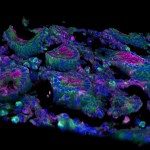Link to Pubmed [PMID] – 17067202
Radiat. Res. 2006 Nov;166(5):746-56
Accurate estimation of the dose of ionizing radiation to which individuals have been exposed is critical for therapeutic treatment. We investigated whether gene expression profiles could be used to evaluate the dose received, thereby serving as a biological dosimeter. We used cDNA microarrays to monitor changes in gene expression profiles induced by ionizing radiation in mouse total blood. The subsets of genes best characterizing each dose were identified by resampling the original data set and calculating the intersection of the dose signatures. This analytical strategy minimizes the impact of potential genetic/epigenetic variation between mice and overcomes the bias in gene selection inherent to microarray technology. The significance of the identified signatures was evaluated by monitoring the type I error rate by in silico negative control simulation. Based on the distribution of the mean ratios of the selected probes, we were able to identify transcription profiles giving 83% to 100% correct estimation of the dose received by test mice, demonstrating that the selected probes could be used to determine the dose of radiation to which the animals had been exposed. This method could potentially be generalized to determine the level of exposure to other toxins and could be used to develop new related clinical applications.

